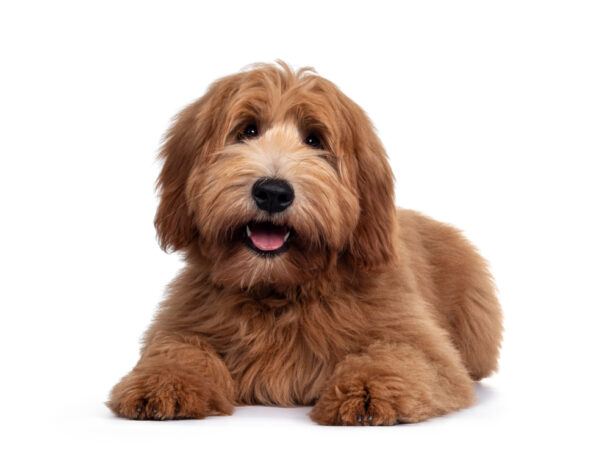LifeWithMyDogs is supported by our audience. When you purchase through one of our links, we may earn a small affiliate commission. As an Amazon Associate I earn from qualifying purchases. Your cost is not affected.
**********
The dog bathing process is more than just a routine chore—it plays a crucial role in maintaining the health and hygiene of your furry companion. Regular dog bathing is essential, from keeping their coat clean and shiny to preventing skin irritations and infections. As a responsible dog owner, it is vital to understand the importance of bathing and acquire the necessary tips and tricks, incorporating animal bathing techniques, to ensure a successful and enjoyable experience for you and your dog.
Bathing your dog also provides an opportunity to inspect their overall health. During bath time, you can check for any abnormalities, such as lumps, rashes, or wounds on their body. Bathing can be a bonding experience between you and your dog. It is an opportunity to spend quality time together and strengthen your relationship. By making bath time fun and rewarding, using treats and praise, you can create a positive association for your dog, making the entire process more enjoyable for both of you.
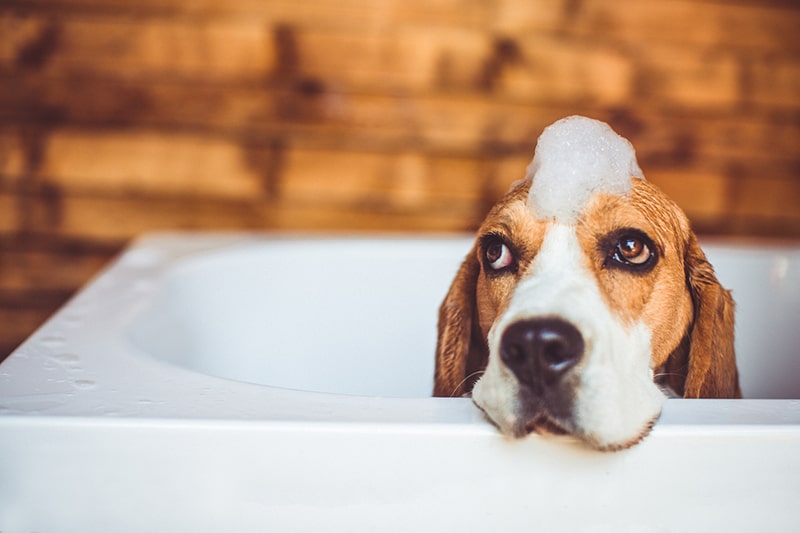
Understanding the importance of dog bathing and implementing the right tips and tricks will keep your furry friend clean and healthy and contribute to their overall well-being. So, let’s delve into the various techniques, considerations, and troubleshooting strategies to help you master the art of bathing your dog effectively.
Proper safety measures in dog bathing offer numerous benefits for your furry friend. By using dog shampoo and following the correct techniques, you can keep your dog’s coat, skin, and overall health in optimal condition. Here are some key advantages of regular and proper dog bathing:
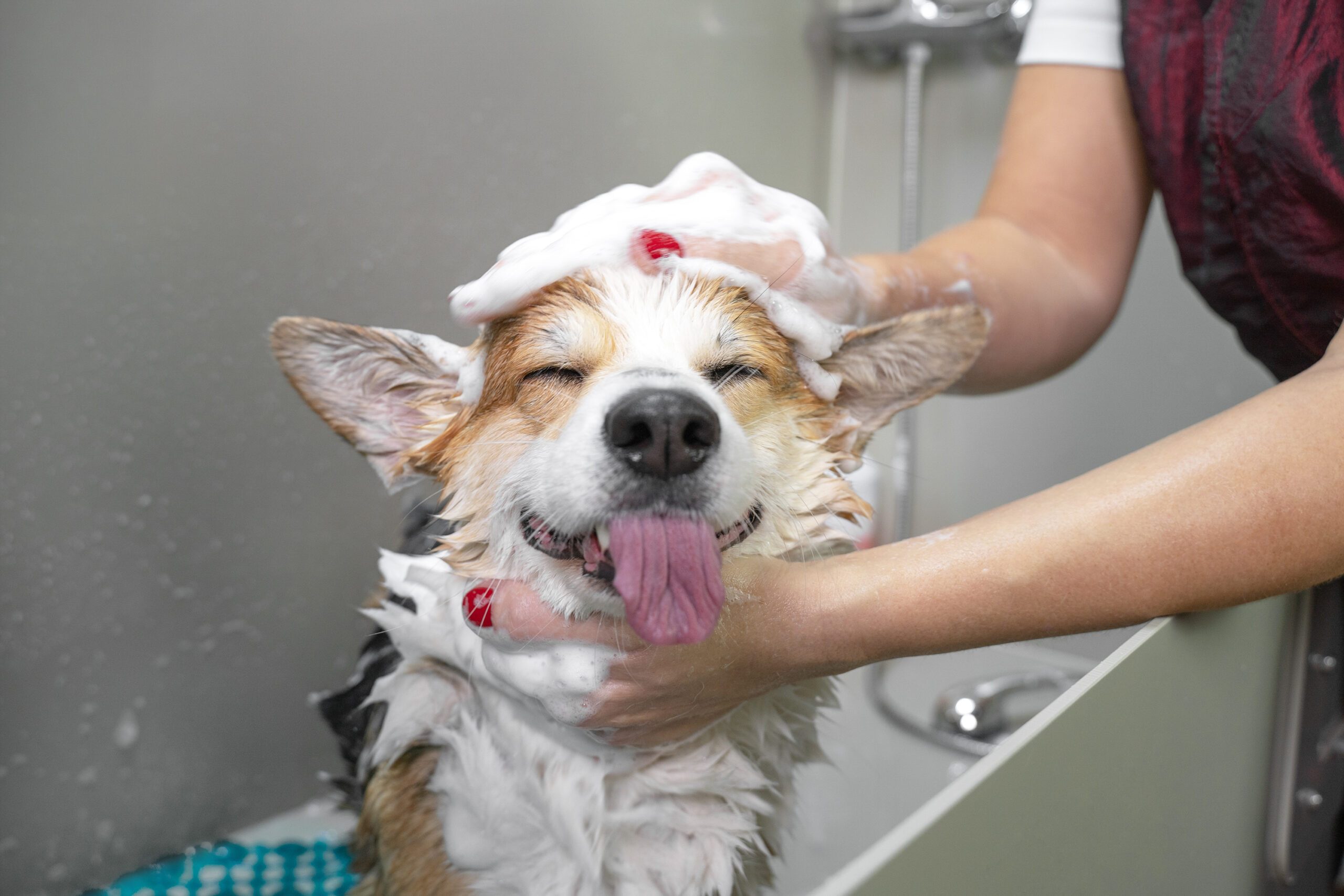
Cleanliness
Bathing your dog helps remove dirt, debris, and unpleasant odors from their coat, leaving them clean and fresh-smelling.
Coat and Skin Health
Regular bathing promotes a healthy coat by removing loose hair and preventing matting. It also stimulates blood circulation and distributes natural oils, resulting in a shinier and softer coat. Additionally, bathing can help alleviate dryness, flakiness, and itchiness associated with certain skin conditions.
Allergen Reduction
Regular grooming of dogs, including activities like bathing, can reduce allergens, such as pollen or dust, that may accumulate on your dog’s fur. This is particularly beneficial for individuals with allergies or asthma.
Prevention of Skin Infections
Proper bathing helps prevent skin infections by removing bacteria, fungi, and parasites that can lead to various skin issues.
Ear Care
While bathing, you can use a specialized dog ear cleanser to gently clean your dog’s ears and remove excess wax and debris, reducing the risk of ear infections. Additionally, applying a dog ear powder afterwards can help maintain ear hygiene and prevent future issues.
Eye and Facial Care
Bathing provides an opportunity to clean your dog’s face and eyes, removing dirt and tear stains.
Dental Hygiene
Though not a substitute for regular brushing, bath time can be an opportunity to introduce your dog to toothbrushing and promote oral hygiene.
Bonding and Socialization
Bathing your dog can strengthen the bond between you and your pet, as it involves gentle handling and positive interaction. Incorporating essential safety tips into the bathing routine also helps socialize your dog to the process, making future baths easier.
Early Detection of Health Issues
While bathing, you can thoroughly examine your dog’s body, looking for abnormalities, lumps, or skin irritations. Early detection of such issues can lead to timely veterinary intervention.
Preparing for the Bath
This guide provides comprehensive tips and tricks for bathing your dog effectively and efficiently. Preparing properly is crucial before bathing to ensure a positive experience for you and your furry companion. So let’s prepare to make bath time an enjoyable experience for your beloved canine friend!
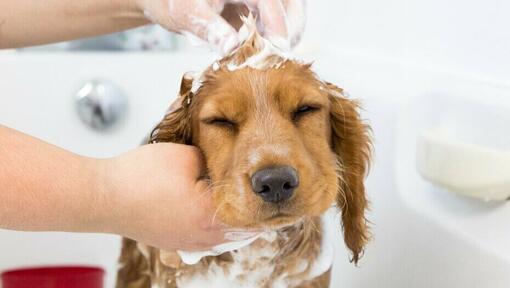
Gathering Necessary Supplies
Before bathing your dog, gathering all the necessary supplies is important. This will ensure that the bathing process goes smoothly and efficiently. Here are the essential supplies you’ll need:
- Shampoo formulated for dogs: Use a dog-specific shampoo, as human shampoos may contain ingredients that can irritate a dog’s skin. Dog shampoos are designed to maintain the natural oils on a dog’s coat and promote a healthy coat and skin.
- Towels: Have several towels on hand to dry your dog after the bath. Choose towels that are absorbent and large enough to wrap around your dog comfortably.
- Brush or comb: Brushing your dog before the bath helps remove tangles, mats, and loose hair. It also helps distribute natural oils and stimulates the skin.
- Cotton balls (optional): If your dog has sensitive ears, you can place them in their ear canals to prevent water from entering and causing ear infections. Be careful not to push the cotton balls too far into the ears.
- Treats or rewards: Keep some tasty treats or rewards nearby to reward your dog’s cooperation during the bath. This positive reinforcement can make the experience more enjoyable for both of you.
Choosing the Right Bathing Area
Choosing the right bathing area is an important aspect of successful dog bathing. Whether you opt for indoor or outdoor bathing and decide between a bathtub, sink, or shower, the bathing environment can significantly impact the experience for you and your furry friend.
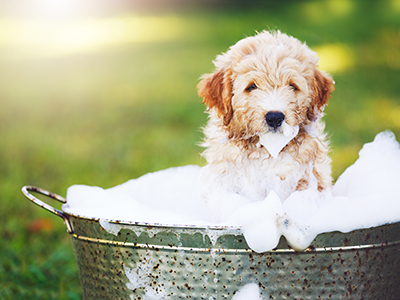
Indoor vs. Outdoor Bathing
Both provide different advantages depending on your specific circumstances.
Indoor bathing is ideal for controlling the bathing process, especially for dogs that may get easily distracted or anxious in outdoor settings. It also offers convenience and comfort, allowing you to regulate the water temperature and have all the supplies within reach.
Outdoor bathing can be great for larger dogs or those who enjoy the experience. It provides ample space for them to move around and shake off excess water without causing a mess inside the house.
Bathtub vs. Sink vs. Shower
When choosing the specific bathing area indoors, you can consider the bathtub, sink, or shower.
- Bathtubs are popular as they provide a contained space and reduce the risk of a wet dog running loose. It also allows for easier access and control, especially when bathing smaller dogs.
- A sink can be a suitable alternative for small dogs, making lifting them in and out of the water easier. However, it may not be suitable for larger dogs due to space limitations.
- Shower can be convenient, especially for larger dogs. It provides easy access to water and allows you to rinse the dog thoroughly.
Each dog is unique, and their bathing preferences may vary. Some dogs enjoy bath time and eagerly jump into the water, while others require more patience and gentle encouragement. Choosing the right bathing area and creating a positive and comfortable experience can ensure a successful dog bath that maintains their healthy coat and promotes their overall well-being.
Bathing Techniques
Properly bathing your dog can make the experience easier and more enjoyable for you and your furry friend. This section will outline some essential bathing techniques that will help you keep your dog clean and healthy.

Brushing Before the Bath
Before you begin the bathing process, it’s important to brush your dog’s coat thoroughly. This step serves two purposes: removing tangles and mats and reducing shedding.
- Removing Tangles and Mats: Use a suitable brush or comb for your dog’s coat type to gently remove any tangles or mats. Start from the outer layer and work through the fur, not pulling or tugging too hard. This step ensures that the Shampoo can penetrate the entire coat during the bath.
- Reducing Shedding: Brushing your dog’s coat before the bath helps to loosen and remove loose hair. This reduces shedding during the bath and prevents clogged drains and excess hair around the house. Be thorough in brushing, paying attention to all areas of your dog’s body.
Wetting the Dog
Now that your dog’s coat is free from tangles and loose hair, it’s time to wet your dog. Follow these steps to ensure a successful dog bath:
- Using Lukewarm Water: Fill the bathing area with lukewarm Water. Ensure the water temperature is comfortable for your dog, neither hot nor cold. Test the Water with your hand or a thermometer to ensure it’s at the right temperature.
- Avoiding Water in the Ears and Eyes: Be cautious when wetting your dog’s head to prevent discomfort and potential issues. Use a damp cloth to clean their face, avoiding the eyes and ears. You can also use cotton balls to protect the ears from Water, but remove them promptly after the bath.
Applying the Shampoo
Choose a dog shampoo specifically formulated for your dog’s breed and coat type. Follow these steps to apply the Shampoo effectively:
- Diluting the Shampoo if Necessary: Some shampoos may require dilution. Read the instructions on the bottle and dilute the Shampoo accordingly. Avoid using human Shampoo, as it can strip the natural oils from your dog’s skin and cause irritation.
- Massaging the Shampoo into the Coat: Apply the Shampoo to your dog’s coat and massage it gently, working it into a lather. Pay attention to areas more prone to dirt or odors, such as the paws, underbelly, and tail. Be careful around sensitive areas, and use a gentle touch.
Rinsing Thoroughly
Thorough rinsing is crucial to remove all traces of Shampoo from your dog’s coat. Follow these steps to ensure a complete rinse:
- Ensuring No Shampoo Residue Remains: Rinse your dog’s coat thoroughly, ensuring no residue remains. Residual Shampoo can cause skin irritation and discomfort. Continue rinsing until the water runs clear.
- Paying Extra Attention to Sensitive Areas: Take extra care when rinsing sensitive areas such as the face, ears, and genital area. Use a cup or your hand to pour Water gently over these areas, avoiding direct pressure that may cause discomfort.
These bathing techniques ensure a successful and pleasant bath time experience for you and your dog. Remember to gather all the necessary supplies, choose the right Shampoo, and create a calm and comfortable environment for your dog’s bath. Regular bathing will contribute to a healthy coat and a happy, clean pup.
Bathing Frequency
Regular bathing is important, but the frequency depends on various factors. These factors include the dog’s breed, coat type, activity level, and lifestyle. Dogs with oily coats or those that spend much time outdoors may require more frequent baths than dogs with drier coats or primarily indoor pets. Additionally, dogs with certain skin conditions may need special bathing schedules recommended by a veterinarian. It’s crucial to strike a balance and not over-bathe your dog, as excessive bathing can strip the natural oils from their skin and cause dryness or irritation.
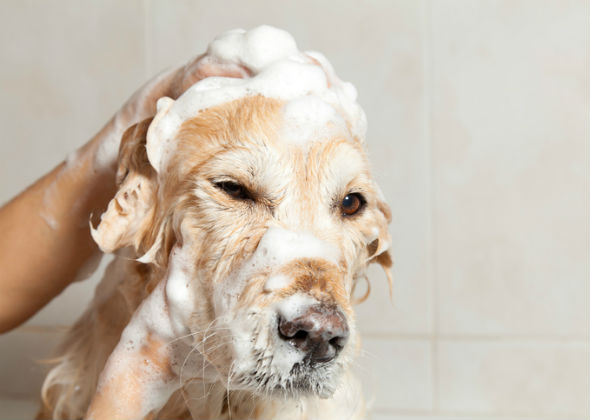
To determine the ideal bathing frequency for your dog, observe their coat and skin condition, and consult with your veterinarian if needed. You can also adjust the bathing schedule based on your dog’s needs and any specific situations they may encounter, such as rolling in mud or swimming in a dirty pond.
Dealing with Specific Coat Types
Long-Haired Breeds
- Brush your dog’s coat thoroughly before bathing to remove tangles or mats. This helps prevent further matting when the coat gets wet.
- Use a dog shampoo specifically formulated for long-haired breeds. These shampoos help detangle the fur and keep it manageable.
- Rinse the coat thoroughly to ensure no shampoo residue is left behind, as it can cause skin irritation or dryness.
- After the bath, gently towel dries the coat, and consider using a blow dryer on a low heat setting, keeping it at a safe distance to prevent overheating or discomfort.
Short-Haired Breeds
- While short-haired breeds may require less maintenance, they still benefit from regular bathing.
- Use a mild dog shampoo suitable for their coat type.
- Pay attention to areas like the ears, face, and paws, where dirt and debris accumulate.
- Rinse the coat thoroughly to remove all the shampoo residue.
- Towel dry or air dries the coat, depending on your dog’s preference and thickness.
Bathing Puppies
Bathing puppies require extra care and a gradual introduction to the bathing process. Follow these tips to ensure a positive experience for your furry friend:
- Start by introducing your puppy to water gently and positively. You can use a shallow basin or sink filled with a small amount of warm water.
- Use puppy-specific shampoos, as they are formulated to be gentle on their sensitive skin.
- Keep the bathing sessions short and provide plenty of praise and treats to associate bath time with positive experiences.
- Avoid water near their eyes and ears when wetting your puppy’s head. You can use a damp cloth or cotton balls to clean their face and ears separately.
- Gradually increase the water level and work towards using a bathtub or shower as your puppy grows older and more comfortable with the bathing process.
In this video, you will learn how often you should bathe your dog for optimal hygiene and care.
Video Credit: @AnimalWised
Drying and Finishing Up
After giving your dog a refreshing bath, the next step is to ensure they are properly dried and groomed. This final stage of the bathing process is crucial for maintaining a healthy coat and preventing discomfort or skin issues. In this section, we will explore the techniques of towel drying, using a blow dryer (if applicable), and performing post-bath grooming tasks such as brushing, removing tangles and mats, and trimming nails or cleaning ears if needed.
Towel Drying
- Patting the coat dry: Once you have rinsed off all the Shampoo, gently pat your dog’s coat with a towel. Avoid rubbing vigorously, as this can cause tangles and create friction, irritating the skin. Instead, press a soft towel against your dog’s fur to absorb excess moisture. Pay extra attention to the areas where your dog tends to retain more water, such as the belly, paws, and under tail.
- Using multiple towels if necessary: If your dog has a thick or long coat or gets exceptionally wet, you might need more than one towel to dry them effectively. Start with one towel, and if it becomes saturated, switch to a dry one to continue absorbing moisture. Repeat this process until your dog’s coat feels damp rather than wet.
Using a Blow Dryer (if Applicable)
- Using a low heat setting: Some dogs may be comfortable with blow dryers, while others may find them distressing. If your dog is accustomed to blow dryers or has a thick coat that takes longer, you can use a blow dryer in a low heat setting. Keep the dryer at a safe distance to prevent overheating and ensure your dog feels comfortable. Remember to continuously move the dryer around to prevent concentrating heat in one area.
- Keeping the dryer safe: When using a blow dryer, maintain a safe distance between the dryer and your dog’s skin to avoid any potential burns. Regularly check the airflow temperature by placing your hand between the dryer and your dog’s coat. If it feels too hot for your hand, it is likely too hot for your dog. Adjust the heat or consider air-drying if your dog becomes anxious or uncomfortable.
Brushing and Grooming After the Bath
- Removing tangles and mats: Once your dog’s coat is mostly dry, it is essential to brush them thoroughly. Use a brush or comb appropriate for your dog’s coat type and gently work through any tangles or mats. Start from the base of the hair and gradually work your way up, being careful not to tug or pull too hard. Regular brushing helps remove loose hair, prevents matting, stimulates blood circulation, and promotes a healthy coat.
- Trimming nails and cleaning ears (if needed): While your dog is still fresh from the bath and their nails are softened, it is an opportune time to trim their nails if necessary. Use a dog nail clipper, and be cautious not to cut too close to the quick, sensitive area inside the nail. Additionally, if your dog’s ears appear dirty or have excessive wax buildup, you can gently clean them using a dog-specific ear-cleaning solution and cotton balls. Avoid inserting anything deep into the ear canal, and consult a veterinarian if you notice any signs of infection or discomfort.
Safety Considerations When Bathing
When bathing your dog, it’s important to prioritize safety and take certain precautions to ensure a successful and stress-free bathing experience for you and your furry friend.
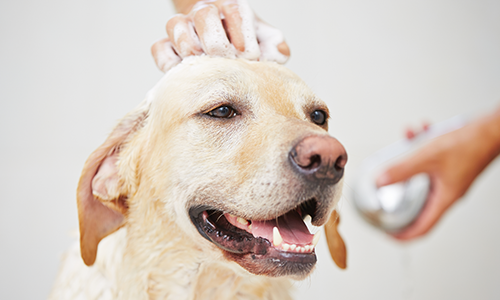
- Protecting your dog’s eyes, ears, and nose: Avoid getting water in these sensitive areas, as it can cause discomfort and potential complications. Gently shield your dog’s eyes with your hand or use a damp cloth to wipe the face while being careful around the ears and nose.
- Preventing accidents with a nonslip mat or towel: Place a rubber bath mat or a towel on the bottom of the bathtub or sink to provide traction and prevent your dog from slipping and injuring themselves during the bath. This is particularly important for larger dogs or those with mobility issues.
- Ensuring proper ventilation and avoiding drafty areas: Ensure the bathing area is well-ventilated to prevent overheating and ensure a comfortable environment for your dog. Avoid drafty areas as they can cause chills and discomfort during and after the bath.
Some Additional Tips to Consider
Not all dogs are comfortable bathing, so creating a safe and secure environment is crucial. Here are some additional tips to consider:
- Use mild shampoo specifically formulated for dogs to avoid skin irritation and maintain the natural oils on their coat.
- Place cotton balls in your dog’s ears to prevent water entry and reduce the risk of ear infections.
- Maintain an appropriate warm but not too hot water temperature to keep your dog comfortable throughout the bath.
- Towel dry your dog after bathing, removing excess water and ensuring they don’t get too cold. If your dog is comfortable, you can also use a blow dryer in a low, cool setting.
- Regular grooming and brushing can help maintain a healthy coat, remove loose hair, and prevent matting.
If you need more clarification about the bathing process or have a dog with specific needs, consider consulting a professional groomer for assistance. They can provide guidance tailored to your dog’s breed, coat type, and any potential skin problems. By prioritizing safety and following these guidelines, bath time can be a positive and enjoyable experience for your canine companion.
Splish, Splash, Success! The Secret to a Tail-Wagging Bath Time Experience!
Regular dog bathing is essential for maintaining your pet’s hygiene and overall well-being. By following the tips and tricks discussed in this guide, you can ensure a successful bathing experience for you and your dog. Remember to prioritize safety, avoid getting water in sensitive areas like the eyes and ears, and use appropriate bathing supplies such as mild shampoo and cotton balls. Maintaining a clean and healthy coat helps prevent skin problems and infections and promotes a strong bond between you and your furry friend.
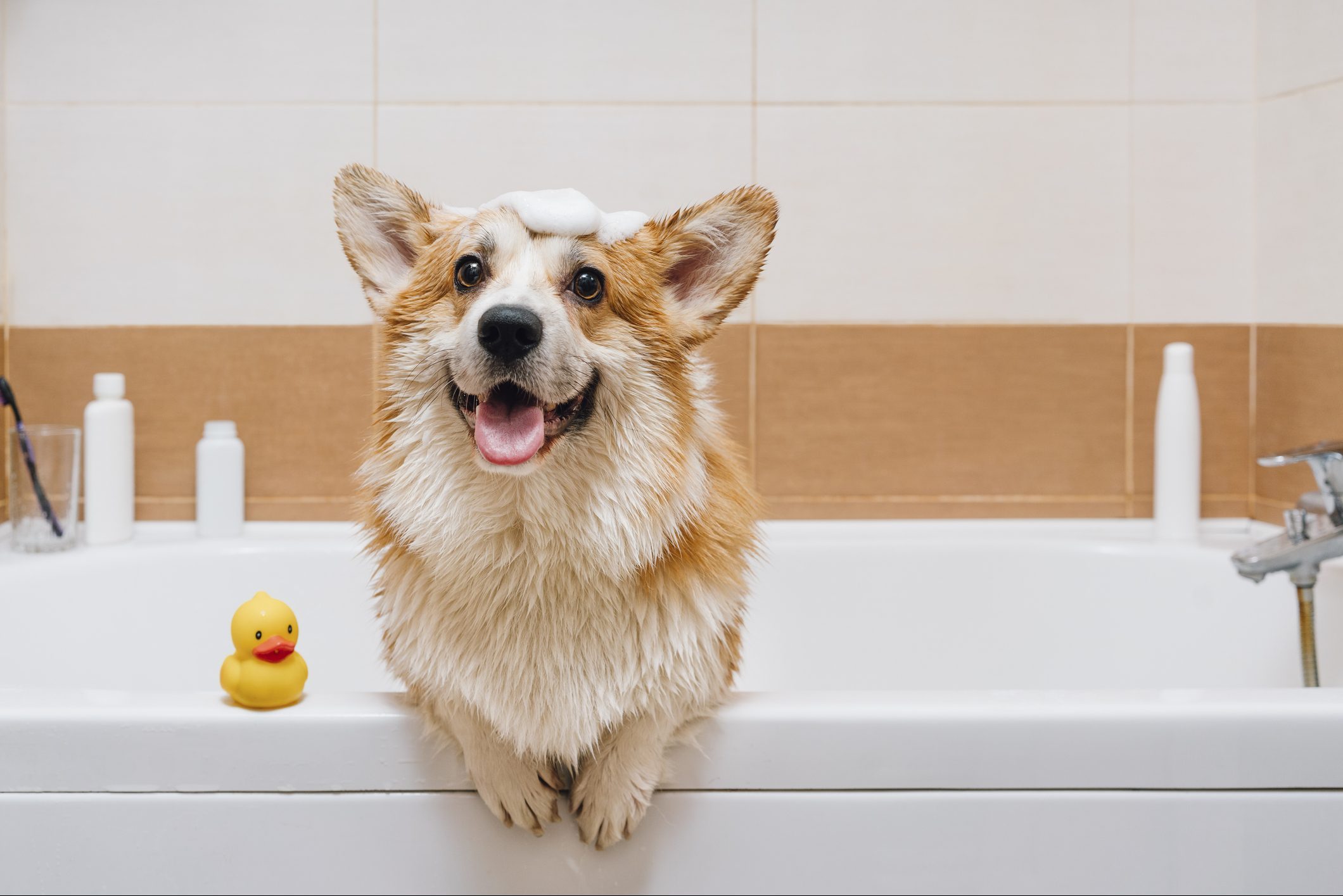
It is highly encouraged to establish a routine for bathing your dog. By making bath time a regular occurrence, your dog will become more accustomed to the process and associate it with positive experiences. Providing treats, praise, and rewards can further reinforce this positive association. Remember to approach each bath patiently, understanding, and caring, catering to your dog’s needs and preferences. Consistency and a positive attitude can create a bathing routine that ensures your dog’s cleanliness, comfort, and happiness.
You can maintain a healthy, clean, and happy companion by incorporating these tips and tricks into your dog’s bathing routine. So, prepare the supplies, create a safe environment, and enjoy the bonding experience that bath time can be for you and your beloved pet.
Frequently Asked Questions
How often should I bathe my dog?
The frequency of dog bathing depends on several factors, such as your dog’s breed, coat type, and lifestyle. Most dogs generally benefit from a bath every 4-8 weeks. However, some breeds with specific coat requirements may need more frequent baths, while others with oilier coats may require less frequent bathing. It’s best to consult your veterinarian or a professional groomer to determine the ideal bathing schedule for your furry friend.
Can I use human shampoo on my dog?
No, it’s not recommended to use human shampoo on dogs. Human shampoos are formulated for the pH level of human skin, which differs from that of dogs. Using human shampoo can disrupt the natural balance of oils on your dog’s skin, leading to dryness, irritation, and potential skin problems. It’s always best to use a mild, dog-friendly shampoo specifically formulated for their needs.
How can I make bath time less stressful for my dog?
Bath time can be stressful for some dogs, but there are several things you can do to make it a more positive experience. Start by gradually introducing your dog to water and using positive reinforcement techniques such as treats and praise. Ensure the water temperature is comfortable, and use a non-slip mat or towel to prevent slipping. Creating a calm and relaxing environment with soft lighting, soothing music, or aromatherapy can help ease your dog’s anxiety during bath time.
How do I prevent my dog's ears from getting water inside?
To prevent water from entering your dog’s ears during bath time, gently place cotton balls into their ear canals. This acts as a barrier, preventing water from getting inside and reducing the risk of ear infections. However, be careful not to push the cotton balls too far into the ears or leave them in for an extended period. Remember to remove the cotton balls once the bath is complete.
What should I do if my dog has sensitive skin or allergies?
If your dog has sensitive skin or allergies, it’s important to choose a hypoallergenic or specially formulated shampoo that is gentle on the skin. Avoid harsh chemicals or fragrances that may irritate their skin further. Also, consult your veterinarian to determine if any underlying allergies or skin conditions need addressing. They may recommend specific bathing techniques or prescribe medicated shampoos to help alleviate any discomfort or skin problems.
Connect with Us Today and Experience the True Meaning of A Dog’s Love and Loyalty!
Join Life with My Dogs, where we celebrate the unconditional love and companionship that dogs bring to our lives. From heartwarming stories and helpful tips to exciting adventures and cute doggie moments, we’re here to share the joy of life with our four-legged friends.
Connect with us on Facebook to be part of a vibrant community of dog lovers, where we engage in lively discussions, share adorable photos, and exchange valuable insights.
Follow us on Instagram for a daily dose of furry cuteness and inspiration as we capture the special moments that make life with dogs extraordinary.
Please take advantage of our curated collection of dog-related content and creative ideas on Pinterest. Explore boards with training tips, DIY projects, delicious dog-friendly recipes, and more.
Follow us on Twitter for quick updates, engaging conversations, and the latest news in the world of dogs.
Join us on this exciting journey and connect with fellow dog enthusiasts who understand our incredible bond with our canine companions.


